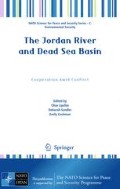Abstract
The level of the Dead Sea has been dropping rapidly over the last decades as a result of diversion of waters from upstream tributaries and intensive mineral extraction along its shores.This has led to a wide range of environmental damage throughout the basin.This study provides partial estimates of the non-market economic value of conservation of the Dead Sea basin to the local population.Two methods were used to assess these values, one a revealed preference model — travel cost — and the other a stated preference model — contingent valuation.All three local populations, Israeli, Jordanian and Palestinian, demonstrated a substantial willingness to pay to preserve the environmental and cultural heritage of the region.Hopefully these estimates will be useful in assessments of the relative merits of various options for conservation and development of the Dead Sea region presently being undertaken by the governments of the region.
Access this chapter
Tax calculation will be finalised at checkout
Purchases are for personal use only
Preview
Unable to display preview. Download preview PDF.
References
Al Weshah, R., 2000. Optimal use of irrigation water in the Jordan Valley: a case study, Water Resources Management, 14(5): 327–338.
Arab Potash Company, 2008. Annual Reports, 1999–2007; http://www.arabpotash.com.
Becker, N., 2001. Strategy of Water.unpublished manuscript (in Hebrew).
Bein, A., 2003.Personal communication.
Blitz, N., Shoratz, D., and Nuessbaum, S., eds., 2001. Water in Israel: Consumption and Production 2001, Water Commission (Israel), Ministry of Infrastructure.December.
Carson, R., Flores, N., Martin, K., and Wright, J., 1996. Contingent valuation and revealed preference methodologies: comparing the estimates for quasi-public goods, Land Economics, 72(1): 80–99.
Central Bureau of Statistics (CBS) (Israel), 2003. Statistical Yearbook of Israel, 2002, Jerusalem.
Central Bureau of Statistics (Israel), 2008. http://www.cbs.gov.il/.
Champ, P., Bishop, R., Brown, T., and McCollum, D., 1997. Using donation mechanisms to value nonuse benefits from public goods, Journal of Environmental Economics and Management, 33(2): 151–162.
Dead Sea Works, 2003. http://www.dsw.co.il.
Diamond, P.and Hausman, J., 1994. Contingent valuation: Is some number better than no number? Journal of Economic Perspectives, 8(4): 455–464.
Dreizin, Y., 2006. Ashkelon seawater desalination project — off-taker's self costs, supplied water costs, total costs and benefits, Desalination, 190: 104–116.
EcoPeace, 1996. Dead Sea Challenges, Jerusalem.
Food and Agriculture Organization (FAO) of the United Nations, 2003.Aquastat — FAO 's Information System on Water and Agriculture; http://www.fao.org/ag/agl/aglw/aquastat/countries/ jordan/index.stm.
Federal Register, 1993. Vol.58, 4016–4614, Office of the Federal Register, National Archives and Records Administration (NARA), Washington, DC.
Freeman, A.M., 2003. The Measurement of Environmental and Resource Values: Theory and Methods, 2nd edition, Resources for the Future Press, Washington, DC.
Friends of the Earth-Middle East (FoEME), 1998. One basin, one strategy, Final Report of the Symposium on Promoting an Integrated Sustainable Regional Development Plan for the Dead Sea Basin.Jerusalem.
Gavrieli, I., 2008. Presentation given at the Knesset (Israeli Parliament).17 November.
Israel Chemicals Limited (ICL), 2008. Harnessing Nature Creating Value: 2007 Annual Report, ICL Group.
Jordanian Department of Statistics, 2003.http://www.dos.gov.jo/dos_home_e/main/index.htmand http://www.nra.gov.jo/mining/mining_sector_in_jordan.htm.
Kislev, Y., 2001. The water economy of Israel.Paper prepared for the Conference: Water in the Jordan Valley: Technical Solutions & Regional Cooperation, University of Oklahoma, International Programs Center, Center for Peace Studies, Norman, Oklahoma, 13–14 November 2001.
Kolstad, C.and Guzman, R., 1999. Information and the divergence between willingness to accept and willingness to pay, Journal of Environmental Economics and Management, 38(1): 66–80.
Magableh, S., 2003. unpublished report and personal communication.
National Academy of Sciences (NAS) (1999). Water for the Future: The West Bank and Gaza Strip, Israel and Jordan, National Academy Press, Washington, DC.
Palestine Economic Pulse, 1996. Palestinian Economic Forum.November.
Palestinian Central Bureau of Statistics (PCBS), 2002.http://www.pcbs.gov.ps/.
Palestinian Central Bureau of Statistics (PCBS), 2003. Impact of the Israeli Measures on the Economic Conditions of Palestinian Households, 5th Round, April–May.
Raz, E., 1993. The Dead Sea Book, Israel Nature Reserve Authority & Tamar Regional Council, Jerusalem (in Hebrew).
Raz, E.and Frumkin, R., 2004. Ecology and Natural and Human Environment, draft background paper on the Dead Sea for the Jerusalem Institute.
Rinat, T., 2007. Dead Sea Level Drops, Hundreds of Sinkholes Threaten Shore, Haaretz, 5 June.(in Hebrew).
Shmuel Neaman Institute, 2007. Decline of the Dead Sea Level: Alternatives in Action, Shmuel Neaman Institute, Haifa (in Hebrew).
Willig, R., 1976. Consumer 's surplus without apology, American Economic Review, 66(4), 589–597.
World Bank, 2002. World Development Indicators 2003, Washington, DC.
World Bank, 2003. World Development Indicators 2004, Washington, DC.
World Bank, 2005. Red Sea— Dead Sea Water Conveyance Project — Feasibility Study — Environmental, Technical and Economic and Environmental and Social Assessment — Terms of Reference, http://siteresources.worldbank.org/MENAEXT/Resources/RDS-TOR-18_ July2007.pdf?resourceurlname=RDS-TOR-18_July2007.pdf.
World Bank, 2008. World Development Indicators, http://web.worldbank.org/WBSITE/ EXTERNAL/ DATASTATISTICS/0, , contentMDK:20398986~menuPK:64133163~pagePK:64133150~p iPK:64133175~theSitePK:239419, 00.html.
Young, R.A., 2005. Determining the economic value of water: concepts and methods, Resources for the Future, Washington, DC.
Author information
Authors and Affiliations
Corresponding author
Editor information
Editors and Affiliations
Rights and permissions
Copyright information
© 2009 Springer Science+Business Media B.V.
About this paper
Cite this paper
Becker, N., Katz, D.L. (2009). An Economic Assessment of Dead Sea Preservation and Restoration. In: Lipchin, C., Sandler, D., Cushman, E. (eds) The Jordan River and Dead Sea Basin. NATO Science for Peace and Security Series C: Environmental Security. Springer, Dordrecht. https://doi.org/10.1007/978-90-481-2989-8_15
Download citation
DOI: https://doi.org/10.1007/978-90-481-2989-8_15
Publisher Name: Springer, Dordrecht
Print ISBN: 978-90-481-2988-1
Online ISBN: 978-90-481-2989-8
eBook Packages: Earth and Environmental ScienceEarth and Environmental Science (R0)

